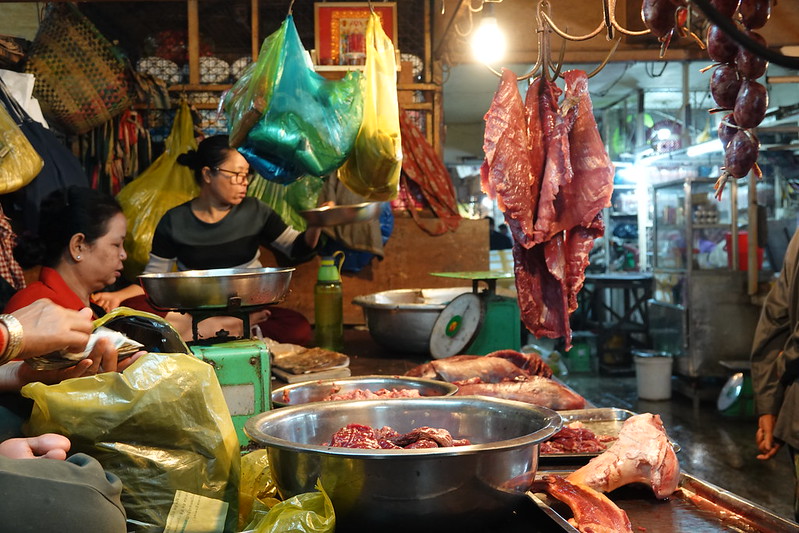A new study by an international team of researchers suggests that in countries where people and livestock live in proximity and use many of the same antibiotics, inadequate sanitation and environmental controls could be aiding the spread of antibiotic-resistant pathogens.
The case study, published last week in Frontiers in Ecology and the Environment, found that strains of antibiotic-resistant Escherichia coli collected from people and meat products sold at markets in Cambodia contained resistance genes and mobile resistance elements that were strikingly similar, which suggests they had been exchanged at some point between humans and animals—a process that is likely occurring on a frequent basis.
The authors say the findings highlight the fact that in low-resource countries where livestock are allowed to roam freely, and access to clean water and sanitation is limited, there is ample opportunity for bacterial pathogens from humans and animals to swap genes and other mechanisms that promote the spread of antimicrobial resistance. And they argue that in similar settings, fixing those issues may be as important in the fight against AMR as efforts to limit antibiotic use in humans and animals.
"Unless we find ways to cut off that circular transmission of bacteria between humans and animals, antibiotic stewardship is not likely to be enough to really address resistance," lead study author Maya Nadimpalli, PhD, an assistant professor at Emory University's Rollins School of Public Health, told CIDRAP News.
Multiple instances of overlap
Nadimpalli said the study is a follow-up to research she worked on in 2016 in Cambodia. One study from that research reported finding highly similar strains of extended-spectrum beta-lactamase (ESBL)–producing E coli in gut-colonized women, infected patients, and meat and fish sold in markets in Phnom Penh, a finding she and her colleagues said supported concerns that the dissemination of drug-resistant bacteria from animals to humans may be more likely in low- and middle-income countries (LMICs).
"We were seeing similar resistance genes and similar sequence types," she said.
But when Nadimpalli presented these data, she frequently received pushback from researchers who questioned the findings and suggested more proof was needed to link the resistant bacteria found in the women and the meat products. One particular question was whether the plasmids—mobile pieces of DNA that harbor resistance genes and can be shared among different bacterial species—were similar.
"They would say 'are you seeing the same plasmids in both populations? Because if you're not seeing the same plasmids, you can't say there's actual sharing going on between human and animal populations,'" she recalled.
For this study, Nadimpalli, along with researchers from the Pasteur Institutes of France and Cambodia and scientists from Denmark, Belgium, and the United States, set out to find further evidence for the links documented in the earlier study. They did this by performing long-read genomic sequencing on five ESBL-producing E coli isolates from healthy, gut-colonized people and pork and chicken meat sold at a Phnom Penh market. They then identified the ESBL-encoding plasmids in the genomes, annotated them, and compared them with previously published Cambodian collections of ESBL-producing bacteria.
Unless we find ways to cut off that circular transmission of bacteria between humans and animals, antibiotic stewardship is not likely to be enough to really address resistance.
They found four distinct ESBL-encoding plasmids shared among the human and animal E coli isolates. Three of the four plasmids contained a region of DNA—called a transposon—that can move from one genomic region to another and confers resistance to third-generation cephalosporins and fluoroquinolones—antibiotics commonly used in people and farm animals in Cambodia that are likely providing selective pressure.
And when they looked at the wider collection of ESBL-producing bacteria from Cambodia, Nadimpalli said, they found that same transposon everywhere.
"Although we only sequenced five ESBL-producing E coli isolates for this case study, which represent only a small fraction of the bacteria colonizing the guts of humans and food animals in this setting, the multiple instances of overlap that we observed suggest that plasmid sharing among vertebrate hosts is not uncommon," Nadimpalli and her colleagues wrote.
Plugging the leaks

Nadimpalli said that while these findings are scientifically interesting, what's more interesting to her is the bigger story they tell about the "leaks" at the human-animal interface in low-income settings like Cambodia.
Most research that looks at links between drug-resistant bacteria in humans and food-producing animals, she noted, is conducted in high-income countries with access to clean water and sanitation and more separation between humans and farm animals. That research tends to focus on the limited avenues for resistant pathogens to spread from animals to humans in high-income settings—such as working on farms or eating contaminated, undercooked meat.
But in Cambodia, which has the highest rate of open defecation in South East Asia and the lowest access to piped drinking water, opportunities for bacteria to circulate and pass back and forth between humans and animals are much more abundant. Animals and people are in much closer contact, and both drink water that's contaminated with human and animal waste and resistant bacteria. Furthermore, that water is used to grow vegetables that are eaten raw.
To combat this threat, experts will have to address the lack of basic sanitation and other environmental controls that are leading to the emergence and spread of antibiotic-resistant pathogens that threaten us all.
And while their study focused on Cambodia, Nadimpalli and her colleagues believe those leaks are likely to exist in other LMICs. They noted in the paper that surveillance studies in LMICs in Africa, Asia, and South America have found overlapping ESBL gene types among bacteria from humans and animals.
"I think this is happening in a lot of places," she said. "There are just so many ways for bacteria to pass back and forth between humans and animals in many countries."
And that means those countries, in addition to reducing the inappropriate antibiotic use that fuels the emergence of resistant bacteria, will need to plug the leaks that promote that circular transmission of bacteria between humans and animals. One way to do that would be by improving the water, sanitation, and hygiene (WASH) infrastructure both in human communities and food-animal production.
"To combat this threat, experts will have to address the lack of basic sanitation and other environmental controls that are leading to the emergence and spread of antibiotic-resistant pathogens that threaten us all," study coauthor Lance Price, PhD, founder and co-director of George Washington University's Antibiotic Resistance Action Center, said in a university press release.
CIDRAP senior veterinary epidemiologist Jamie Umber, DVM, MPH, said the study reinforces the fact that context matters and that efforts to address AMR need to take context into account.
"There is increasing evidence that ecology, physical circumstances, and relationships between organisms (including humans), play a significant role in the spread of AMR," she said. "Particularly in low- and middle-income countries, critical control points to reducing AMR spread likely exist at environmental interfaces between humans and animals."
























